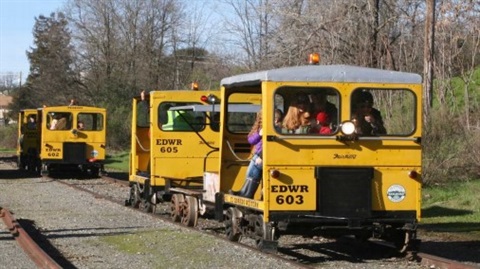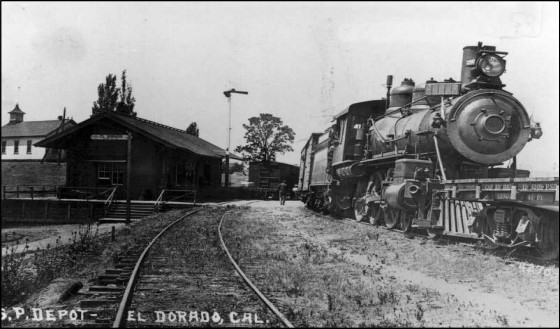El Dorado Western Railroad

The El Dorado Western Railroad currently operates its excursion railroad program on the Placerville Branch between Shingle Springs and Missouri Flat Road. Originally there were five combined freight and passenger depots, built to standard Southern Pacific Railroad designs, in Latrobe, Shingle Springs, El Dorado, Diamond Springs and Placerville. The only existing structure is a portion of the Shingle Springs freight depot, built after a devastating 1896 fire burned the original 1865 station. The town of El Dorado now has a scaled version of the El Dorado Station through the generosity of volunteers and donors.
Rides are given on historic Gang Cars which were used by railroad inspectors, officials, workers, and others to travel the rails. The round trip takes about 40 to 45 minutes, and will return you to the place you boarded. Maximum speed is 10 mph, and road crossing safety protocols are followed.
Video about the El Dorado Western Railroad and the history of railroads in El Dorado County
Produced in 2014 as part of the "Touch the Past" series, a collaboration between the El Dorado County Historical Museum and the El Dorado County Library.
Schedule
The RAILROAD will be closed November 24 due to the winter storm, December 1 for the Thanksgiving Holiday, and December 8 due to participation in Placerville's annual "Hangtown Christmas Parade.
Plan to visit us on December 7 in honor of the grand opening of Wise Gals Coffee in the historic Shingle Springs Depot at 4241 Mother Lode Drive, Shingle Springs.
Please check the railroad's Facebook page for the most current information.
The Railroad's regular schedule* is:
 Boarding at the El Dorado Station on 1st and 2nd Sundays
Boarding at the El Dorado Station on 1st and 2nd Sundays
4650 Oriental Street, El Dorado, CA
Boarding at the Shingle Springs Depot on 3rd and 4th Sundays
4241 Mother Lode Drive, Shingle Springs, CA
*If raining, snowing, thunderstorms in the area, or extreme heat, rides will be cancelled for that day. Please call 530.663-3581 to check.
Rides are on Vintage Inspection Cars
Rides leave at 10AM, 11AM, 12PM and 1PM.
Tickets
- Ages 9 and up: $8
- Ages 3-8: $3
- Under age 3: Free
Space is limited, and tickets are sold "first come, first served."
Tickets go on sale at 9:30 AM at the Station and can be purchased for any scheduled ride for that day if space is available.
Call (530) 663-3581 on Sundays for the time of the last ride or to see if space is available.
Download a flyer with current information about the El Dorado Western Railroad(PDF, 199KB)
, including location and directions, schedule, tickets, volunteer information and even some El Dorado County railroad history!
Railroad Events
This element requires javascript to be enabled.Please wait while we load this calendar...
The Dispatcher: The El Dorado Western Railroad Newsletter
About the El Dorado Western Railroad
Railroads have been an important part of El Dorado County’s history since the Gold Rush. By 1853 the Sacramento Valley Railroad was begun, reaching Folsom in 1856. Placerville merchants and residents pushed to continue the rail line east. Track was laid to Latrobe in 1864 and to Shingle Springs by 1865. It took another 23 years to complete the rail to Placerville. The Southern Pacific Railroad “Placerville Branch” opened for business in 1888 and hauled lumber, fruit, butter and other produce to Sacramento until 1986. There was also a thriving passenger service to and from Sacramento until the early 1940s.
Narrow gauge logging railroads connected the vast stands of timber to lumber mills. Michigan-California Lumber Co. included a cable which carried rail cars of lumber across the American River Canyon from the mill in Pino Grande north of the river to the mill in Camino. The Camino, Placerville & Lake Tahoe Railroad brought lumber to Placerville where it was loaded onto the Placerville Branch railroad line. Another logging railroad, the Diamond & Caldor Lumber Co. had a network of narrow gauge rail east of Grizzly Flat with a lumber mill in Caldor and another in Diamond Springs.
 This 1912 photo shows the El Dorado Depot, built in 1888. It served both passengers and freight on the Placerville Branch of the Southern Pacific Railroad. The El Dorado School, a one room schoolhouse and now the El Dorado Community Hall, is seen at the left edge of the photo.
This 1912 photo shows the El Dorado Depot, built in 1888. It served both passengers and freight on the Placerville Branch of the Southern Pacific Railroad. The El Dorado School, a one room schoolhouse and now the El Dorado Community Hall, is seen at the left edge of the photo.
More Information
See the following links for more information about the El Dorado Western Railroad program, the Foundation (the not-for-profit organization that supports the Railroad) and plans for the future.